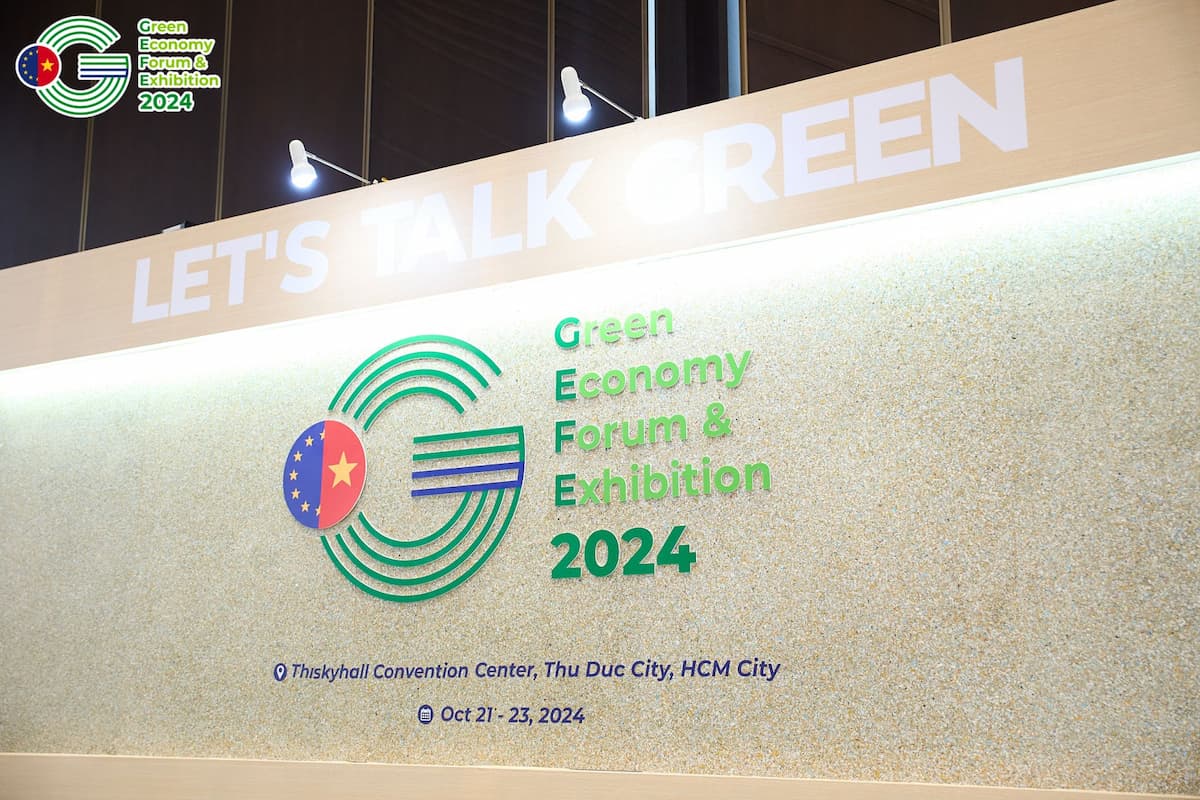
Eurocham Vietnam's GEFE featured various topical discussions and over 200 exhibitors. (Photo: GEFE)
The first part on Vietnam’s renewable energy development went over DPPA’s effect on new projects. The second part will delve into the details of the new mechanism and how companies should weight their green power procurement options.
This article will combine our research and exchanges with industrial experts at the Green Energy Forum and Exhibition (GEFE). The GEFE was an event held by Eurocham Vietnam from Oct 21 to 23, covering multiple topical discussions and inviting over 200 exhibitors. This article will cover what we know about Vietnam’s renewable energy development status and recommendations for investors.
Renewable energy development under PDP 8
The PDP 8 serves as the underlying framework of new renewable energy project development. GEFE commenced with a conference on the development of offshore wind in Vietnam. From the conference and talking to industrial experts, it is safe to say that the target to reach 6 GW of offshore wind is unlikely to happen.
Many investors, equipment suppliers, and international development institutions pointed to the lack of regulatory clarity and supporting policy mechanisms such as investor selection method and offtake price as the main hurdles they face. However, not all hopes are lost. Copenhagen Infrastructure Partners (CIP) openly expressed their confidence in offshore wind development in the long run while recognizing the short-term policy hinderances faced by the industry.
For corporations with significant decarbonization goals, the DPPA rolled out on July 3 is a game changer. The mechanism offers two models of renewable electricity exchange, one is through the national grid, and one via private connection. The table below summarizes the models.
| Model | Description | Pros and Cons |
| Physical PPA (private grid) | Direct power purchase agreement with any renewable power generators. Allows for private negotiations around capacity, transmission, and voltages. |
|
| Virtual PPA (national grid) | Corporates sign a contract with renewable energy producers for the environmental attribute of green power generated and one with EVN for the actual transmission of renewable electricity. Threshold: Large enterprises with monthly electricity consumption of over 20,000 kWh. |
|
The promulgation of the new mechanism injects excitement across the renewable energy industry as it opens the door for more market participants. In the meantime, a few project investors and developments remain cautious on new projects as the new feed-in tariff has not come out yet. An industry expert indicated that the new feed-in tariff will not be announced until Q1 next year the quickest. For now, it seems many are keen on starting with on-site generation and consumption, which come in two forms. One, physical PPA using the private grid; and two, rooftop solar.
Physical PPA, as seen from the description in the table above, has a more flexible contract structure and can bypass the government in decision-making. Many see this as an easier and faster channel for the construction and utilization of new projects. Of course, for actual project construction to begin, businesses are still waiting for more details on the mechanism to ensure all parties are equally protected by the law. One thing we know for industrial consumers for now is that if they are located in industrial zones, it might be easier for them to acquire renewable energy from the governing entities of the zones, who are developers and owners of utility-scale solar farms or rooftop solar projects that supply green power to the industrial zones’ grids.
Rooftop solar on the other hand, has already been utilized by many C&I consumers but is still on the rise. The recent announcement for excess power price to sell back to the national grid is an improvement from previous speculations of zero grid export and all-around cancellation of offtake price. In our view, we think this shortens the payback period of solar panels and encourages household electricity consumers to install solar panels on their roofs. But industrial consumers may benefit better from retailing the excess power, if any, to other industrial consumers. This way not only is rooftop solar power is more efficiently used, but companies will also benefit from greater revenues from rooftop solar installation.
.jpg)
The introduction of the new mechanism in Vietnam injects excitement across the renewable energy industry by creating opportunities for more market participants. (Photo: iStock)
Things to watch out for
Over the past six months, Vietnam has made several significant policy advancements in the renewable energy sector. We believe now is the right time to start thinking about solar investment and development, but it may take another six months for things to really start rolling on the ground.This is mainly due to pending details on project participation mechanism and EVN fees under the virtual PPA model, as well as the feed-in tariffs for new renewable projects.
Apart from solar projects, we think that energy storage has an increasingly big role to play in the liberalizing market in Vietnam given growing attention on grid stability with the expected growth of new intermittent renewable energy projects. Another thing we advise companies to take action on is their renewable energy certificate (REC) purchases. We foresee the unbundled REC market to experience price fluctuation because DPPA promises more generous prices for project developers and owners, which will inevitably drive supply out of the REC market.
In sum, we are witnessing a thrilling transformation of Vietnam’s electricity market. As much as there are new opportunities for investors and consumers, there are also considerable hesitance and confusion on what to do next. If you have any questions regarding the new green power procurement mechanism or would like to discuss your company’s options, please contact the author.